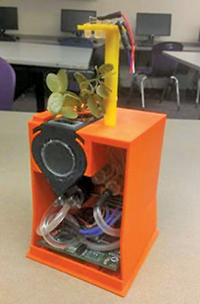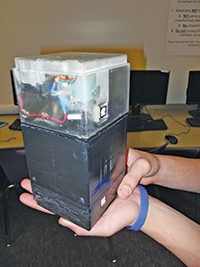Students Use 3D Printing to Prepare Experiment for Space Station
Space Technology
“Our kids can put on their resume that they designed and built an experiment that flew on the International Space Station.” - Matthew Brown, engineering teacher, Lakewood High School and Warren Technical School
A Colorado teacher has figured out how to use 3D printing to take his students to outer space. Matthew Brown teaches engineering and design, sustainability, renewable energy and construction at Lakewood High School and Warren Technical School, both in the Jefferson County, Colorado, school district. When Brown received a new equipment budget a few years ago, he took the opportunity to add a next-level teaching aide to his classrooms.
He researched available 3D printers with his main criterion being the ability to build parts that are strong and durable enough that they can be assembled, machined, finished, handled, tested and used in real-world applications. Brown decided that FDM technology best met his requirements so he purchased a Dimension BST 1200es 3D Printer and later added a Dimension SST 1200es 3D Printer.”
“The 3D printers have helped recruit new students,” Brown said. “When we have an open house I set one up in the hall and kids flock to it.” Brown adds that the school’s program has doubled in size since acquiring its first 3D printer: “My students learn more from their classes because they are able to touch, feel, test and use their projects as opposed to just viewing them on the computer screen. As a result, we retain more students as they move from introductory to advanced classes.””
 Brown’s students are gaining hands-on experience by working on design projects with local businesses. For example, a group of students helped a local company design video game consoles for cruise ships and built the prototypes with a Dimension 3D Printer.”
Brown’s students are gaining hands-on experience by working on design projects with local businesses. For example, a group of students helped a local company design video game consoles for cruise ships and built the prototypes with a Dimension 3D Printer.”
Out-of-this-World Experiment
Jefferson County students have also used the 3D printers to collaborate with a more well-known partner. In 2013, the National Aeronautics and Space Administration (NASA) invited Brown and his students to participate in its High School Students United with NASA to Create Hardware (HUNCH) program. Through the program, NASA partners with schools to help students develop and test NASA-aimed items such as hardware and soft goods. For their project, the Jefferson County students wanted to successfully grow plants in order to provide a possible fresh food source for astronauts and evaluate potential psychological benefits.”
 Plants are difficult to grow in space because the lack of gravity makes water act very differently than it does on earth. Water floats in bubbles and sticks to plants, preventing water from dripping off, causing the plants to either drown or rot. The students designed a plant chamber, called the Hydrofuge, in which the plant is suspended. The chamber is then flooded with nutrient solution. After the roots soak for several seconds, the chamber is drained and a centrifuge spins the plant to simulate gravity, drawing water off the roots. Surface tension holds the water to the sides of the chamber in a zero gravity environment. The specific angle formed by the sides and bottom of the chamber draws water along the sides to the bottom of the chamber by capillary action where it can be pumped. This process repeats several times each day to provide nutrients to the plant.”
Plants are difficult to grow in space because the lack of gravity makes water act very differently than it does on earth. Water floats in bubbles and sticks to plants, preventing water from dripping off, causing the plants to either drown or rot. The students designed a plant chamber, called the Hydrofuge, in which the plant is suspended. The chamber is then flooded with nutrient solution. After the roots soak for several seconds, the chamber is drained and a centrifuge spins the plant to simulate gravity, drawing water off the roots. Surface tension holds the water to the sides of the chamber in a zero gravity environment. The specific angle formed by the sides and bottom of the chamber draws water along the sides to the bottom of the chamber by capillary action where it can be pumped. This process repeats several times each day to provide nutrients to the plant.”
 3D printing played an instrumental role in this experiment. “The 3D printer made it possible for us to go through the complete engineering process,” said Trevor Lucero, a senior at Lakewood High School. The students performed engineering calculations, developed the concept design and printed the two primary system parts – the centrifuge container which includes the root chamber and the water chamber – on a Dimension 3D Printer in ABSplus™ thermoplastic. The two parts were sealed with silicone caulk and bolted together. The students evaluated the prototype, made changes to the design, then printed new prototypes overnight and performed functional testing.”
3D printing played an instrumental role in this experiment. “The 3D printer made it possible for us to go through the complete engineering process,” said Trevor Lucero, a senior at Lakewood High School. The students performed engineering calculations, developed the concept design and printed the two primary system parts – the centrifuge container which includes the root chamber and the water chamber – on a Dimension 3D Printer in ABSplus™ thermoplastic. The two parts were sealed with silicone caulk and bolted together. The students evaluated the prototype, made changes to the design, then printed new prototypes overnight and performed functional testing.”
Zero-Gravity Testing
When they had a design that seemed to work on earth, they tested it in zero gravity at Johnson Space Center in Houston. There were several things that became evident during testing, including which materials worked best as a grow medium for the plants in a microgravity environment and how to use a centrifuge to remove water from the roots. To simplify the design, they moved from an aeroponic nutrient delivery system to a flood and drain system. The size of the first design also had to be reduced by almost 75% for the final design. After five zero-gravity flights, the students’ design appears to work perfectly in a weightless environment. It launched in SpaceX CRS-6, a cargo resupply mission to the ISS, on April 14, 2015. There are now tests being conducted on an aquaponics system to provide nutrients to the plants and provide a new source of protein to Astronauts.”
“Our 3D printers have proven to be well worth the investment. Just think, our kids can put on their resume that they designed and built an experiment that flew on the International Space Station.”



